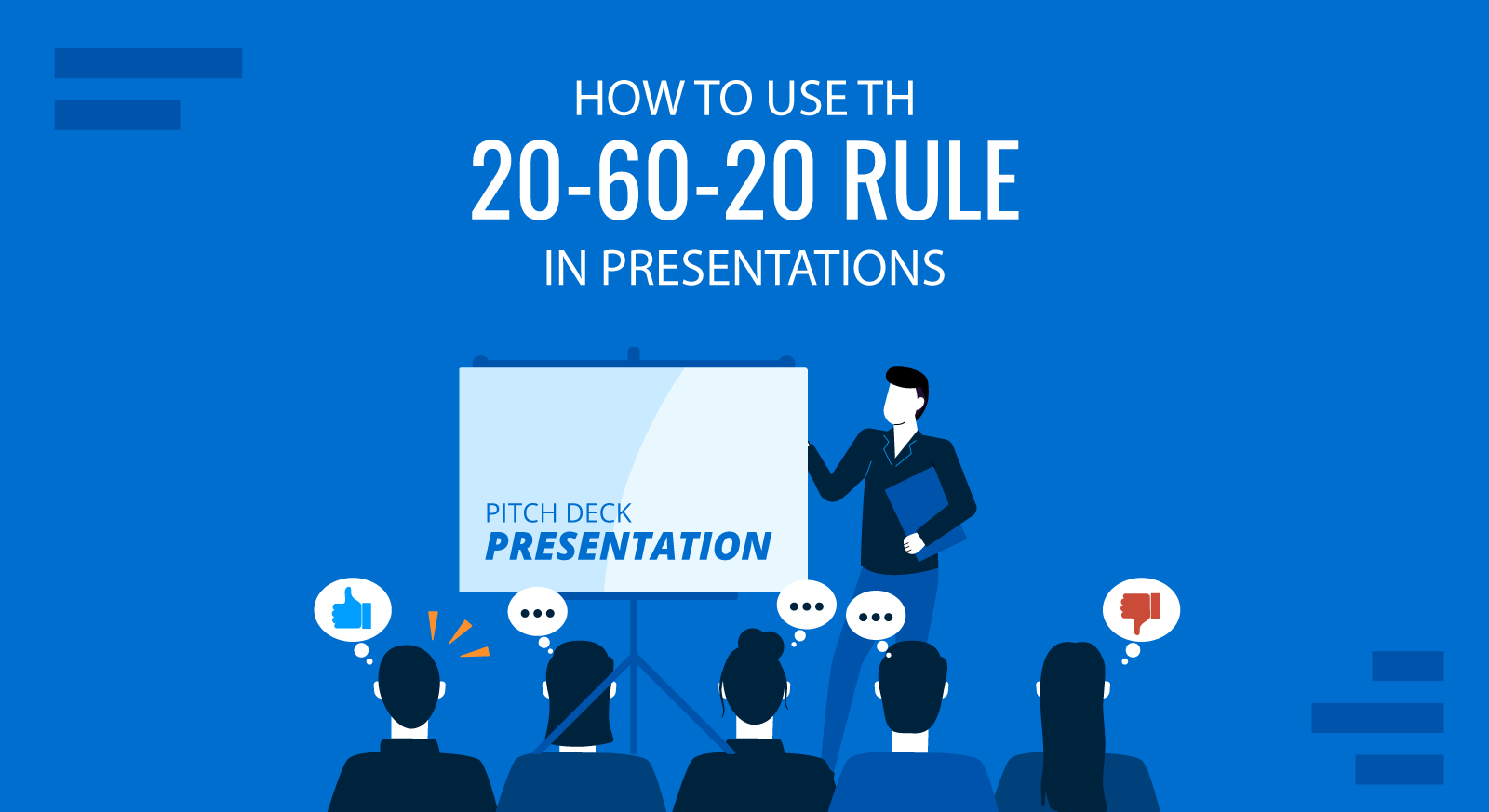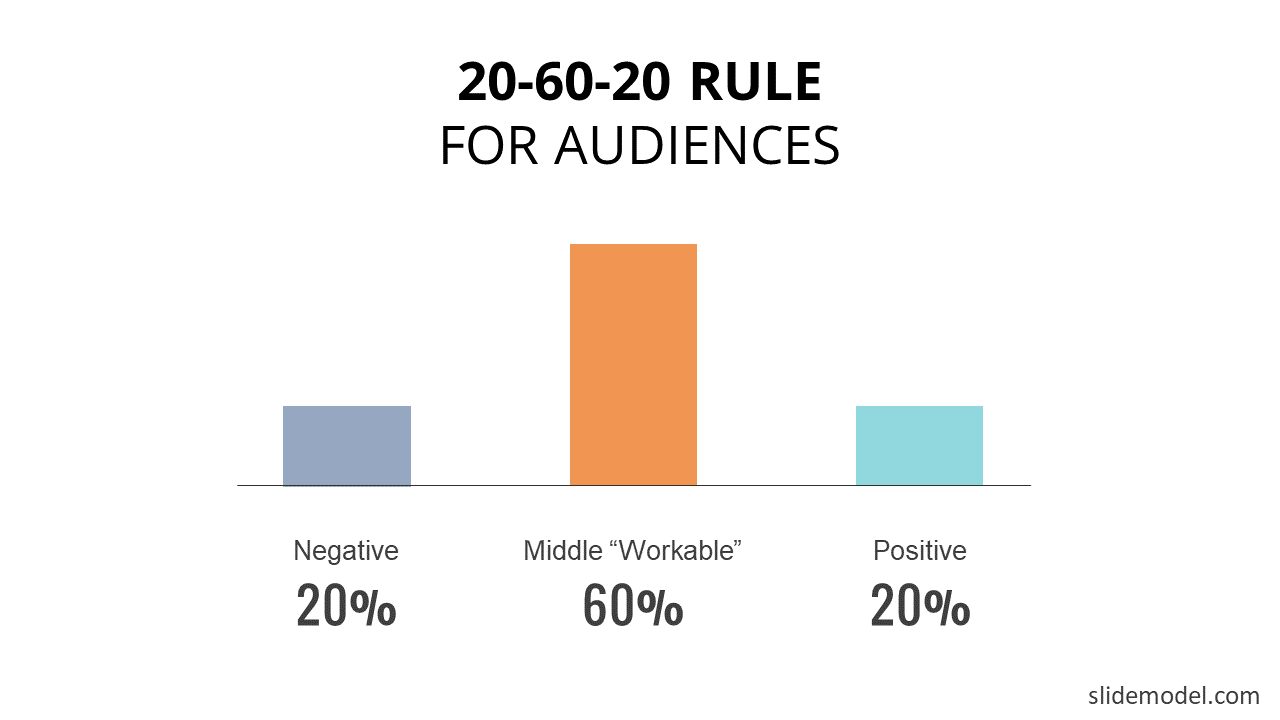
As a presenter, you are looking to influence people and get your message across. However, a minority of individuals can sometimes ruin the prospects of a good presenter. It is not only essential to deliver a good presentation but it is also important to win hearts and minds during the process. This might mean that you will need to manage your audience in order to get the desired result; such as ensuring that your call to action gets noticed and yields results. In order to better manage your audience and to make them more responsive, you can use the 20/60/20 rule.
Importance of the 20/60/20 Rule in Presentations
The 20/60/20 rule can be applied in presentations to influence your audience by dividing them into three segments. These three segments would include:
- 20% people who will receive your message positively.
- 60% with a rather neutral stance.
- 20% who would disagree or take your message negatively.
The same rule can be applied in a wide range of situations, such as in organizations, and when managing your relationship with various individuals. As far as presentations are concerned, you can use this rule to yield better results by applying the rule to your audience and managing them accordingly.
Actionable Ways 20/60/20 Rule Can Help to Effectively Reach Your Audience

a. Influencing the Positive 20%
When delivering a presentation, 20% of people might simply be the ones who agree with your perspective or respond positively to what you have to say. This is the segment that is your strength as a presenter and can help you spread your influence. Make them your supporters.
b. Understanding and Influencing the Middle “Workable” 60%
If you have been delivering presentations for a long time, you would know that many people in the audience can easily swing in their perspective. As is usually the case, many presentations entail new information that the audience is unfamiliar with. This means that the audience receives information that it needs to make up its mind about. At least 60% of the audience is likely to fall into this category. You can influence this segment by effectively gauging the mood of this segment. It might not be a bad idea to conduct a mid-presentation survey or to run a quick poll to gauge if the manageable 60% is onboard.
Remember, this 60% of your audience is a swing vote, i.e. they can either help make your presentation successful, or you might end up with a negative impact, where there is not only the risk of facing embarrassment before your audience but also the chance of a large number of people not receiving your message as expected. As is the case with modern day social media enthusiasm, sometimes, something quite insignificant can often be misinterpreted and translated into social media outrage. Suffice to say, that is not something you would want to deal with! Or in a business environment, where you are trying to close a deal, you can end up adding detractors to your offering just because you were unable to identify the audience that can be convinced with fewer efforts.

c. Making Sure the Negative 20% Don’t Go Overboard
It is unlikely that a presenter can ever convince the whole audience. There will always be a segment which will oppose the presenter’s views or at least have some reservations. This is the negative 20% that you need to watch out for. This is the segment that you don’t want your 60% to get influenced by. This is why it is important to cater for this segment by hearing them out but not allowing them enough space to spread the ‘resistance’. It is not advised to give this segment too much time during Q&A, since many times they can end up raising trivial issues which can ruin your presentation and even misinterpret your message. What you would rather want is to give more time to the positive 20% to be heard more than the negative 20% so that the remaining 60% can be influenced.
It is essential to make the negative 20% feel that they have been heard. You can opt to respectfully disagree with their perspective or give your own views which might be opposite to theirs. Many times when dealing with the negative 20%, it is advisable to look for common ground or to opt for venturing into neutral territory.
Avoiding Major Pitfalls
As a speaker there are major pitfalls that you need to avoid, lest they may end up ruining your presentation. As a presenter you need to not only speak your mind but also keep your emotions in check, while still staying true to your heart.
a. Leave Your Bias at the Door
Understand that different people will have different views and they might not confirm your beliefs and ideals. It is essential to give others space and not to offend anyone just because you have a different point of view. It is also important to respect your audience and not to disrespect anyone.
Unfortunately, being bias is only human nature. It can be hard to not try to impose what you believe in, however, as a presenter you need to leave your bias at the door, be more receptive to different perspectives and most of all, ensure that you duly respect your audience and their perspective, even if you don’t agree with what they have to say.
b. Acknowledge and Understand Your Audience’s Point of View
Say you are delivering a presentation about Global Warming and the effect of industries in polluting the environment. In such a case you might come across people in your audience who might have a bias since their livelihood might depend upon a line of work which generates the same type of pollution that you are looking to gather support against. In such a case there is a conflict of interest which might compel a mild to severe opposition from such a member within the audience. In such a case, you need to acknowledge and understand the point of view of such individual(s) and try to reason with them while keeping in mind their potential issues. For example, in such a case it might not be a bad idea to talk about the need to diversify industries and train the existing workforce towards the use of processes, which involve renewable energy.
What you need to understand is that certain topics might cause anxiety and anger amongst certain members of the audience simply because they might have sensitivities and sentiments which you might not have considered. It is important to think on your feet and to try to stand in the shoes of the one opposing you in order to better respond to their concern or query.
c. Find the Middle Ground and Avoid Arguments
Needless to say, you should avoid getting into arguments, since something apparently docile can often spark a heated conversation. This might end up making you look bad before the manageable 60%, which might end up being better managed by your negative 20% against you.
The safest way to have an argument is to look for middle ground. This can be essential when managing the negative 20%. Even if you disagree with their perspective, looking for middle ground can help allay some of the concerns this segment might have. Furthermore, this will also help you win their trust and influence them. Even if this 20% segment leaves utterly opposed to your views, they might have a tamer reaction, thinking they have been heard.
d. Never Impose Your Views
In the digital age of people looking to hate and malign others to go viral on social media, the worst thing you can do is to impose your views and give social media enthusiasts the gasoline to burn your reputation. Another thing to bear in mind when talking to the negative 20% is to make sure you don’t try to impose your views or look for having the last laugh. Instead, you should try to make your audience think!
e. Make Your Audience Think
When you come across people who don’t agree with you and you’re looking for common ground, there are often two magic words which might help you in such a situation. “What if?”
You can be a financial consultant presenting your plan to make a venture financially lucrative, a small business owner looking to attract investment, an environmentalist hoping for a greener future or a student looking to get a better grade by delivering a good presentation. Either way, you are likely to be discussing something which is yet to happen or has a possibility. More often than not, this entails a better future or changing something for the better. Making people think about that “better future” is what most presenters do. The “what if” in this case can make your presentation more powerful. Here is an example:
Hence, try to focus on the “what if” and look to win hearts and minds.
f. Try to Win Hearts & Minds
It is quite difficult to hate someone who makes you laugh. As a presenter you should look to influence your audience by winning hearts and minds, even if it means cracking a joke about yourself. If you can make your audience think about your perspective, not be offended by your views and leave with a smile on their faces, you are likely to end up with a successful presentation.
To win hearts and minds you should always understand the sensitivities of your audience. Some of this information can be gathered beforehand by analyzing the potential audience which you might come across. Do a bit of digging into what makes them tick, the things they might get offended by and the type of content which might win hearts and minds. For example, an audience which might come from a well-knit community which takes pride in their culture might simply give you a pass on your indiscretions if they believe you respect and appreciate their community. A few words of appreciation regarding their culture and community in this case might help you win hearts and minds. Similarly, talking about what people like, even if it’s a bit off topic might help you get their attention, it could be something as small as a TV show or a sport like baseball which might get your audience excited.
You can also look into metaphors, folklore, and legends popular among your audience. This might be easier to do if you are addressing an audience from a specific culture, religion, community or nationality. For the more diverse audience, you can look for aspects which might appeal to them in general. For example, if you’re addressing an audience which includes business professionals from around the world, talking about business, financial gain and a few related jokes might just keep your audience more attentive.
Final Words
As a presenter, you need to be open-minded, patient, respectful and focused on what you intend your audience to take away from the presentation. While it is easy to be tempted to be patronizing to win hearts and minds, it is advised to rather stick to what you truly believe in. As a presenter your strength should never be in being manipulative but rather honest.
A presenter who speaks from the heart is more likely to win hearts and minds and not be afraid of being exposed because of his/her hypocrisy. If you preach what you truly believe, respect even those who ardently oppose your views, you will be able to gain their respect and a milder response from the negative 20%, allowing the positive 20% to influence the manageable 60%, making the 20/60/20 rule to work in your favor.


